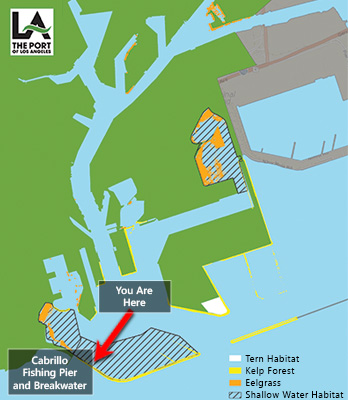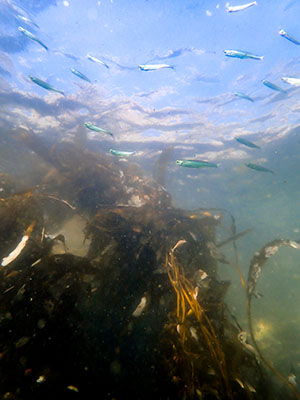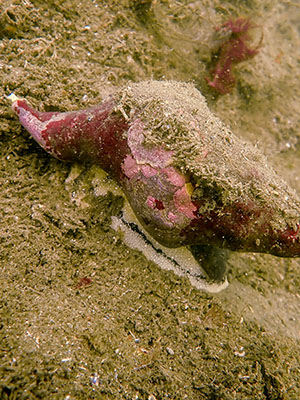
Cabrillo Fishing Pier and Breakwater

You Are Here
Cabrillo Fishing Pier gives visitors the chance to try their hand at targeting popular sport fishes that are common in the harbor, such as bass, halibut, mackerel, and rockfish. A walk along the pier also gives visitors a view of the kelp forest that grows along the breakwater, creating a visible canopy at the surface.
On this Page:

Habitats Located at
Cabrillo Fishing Pier and
San Pedro Breakwater
Habitats near the fishing Pier and the breakwater include riprap and the associated kelp forest, open water, and sandy seafloor that slopes from the shallow areas near the breakwater and the beach into deep navigation channels that
are maintained for commercial shipping operations.
Hover over the images below to learn more about the different habitats located at the Cabrillo Fishing Pier and San Pedro Breakwater!

Riprap
The breakwater is composed of large boulders that form caves and crevices that provide shelter for animals such as garibaldi, horn sharks, and abalone. Kelp also attaches to these boulders, forming a vertical habitat with a canopy reaching the surface that is similar to a forest in terrestrial habitats. The giant kelp supports numerous fishes such as kelp bass and blacksmith while also providing valuable hunting grounds to seals, sea lions, and seabirds that can dive below the canopy to hunt for f...
Learn more!
Pelagic
Open-water areas in the outer harbor are expansive, ranging from shallow areas near the shore to deep areas that fishes can use as refuge to hide from predators. Common animals in this area include schools of baitfish such as anchovy and topsmelt, tiny larval fishes feeding on phytoplankton and zooplankton, marine mammals such as dolphins and harbor seals, and birds that feed on bait fish and rest on the water’s surface.
Learn more!
Seafloor
The seafloor in the outer harbor is primarily sandy in shallow areas, supporting numerous fishes including popular sportfish such as sand bass and halibut. Deeper, muddy sediments are home to animals that can burrow, such as clams and worms, in addition to larger invertebrates such as shrimps and crabs that forage along the sediment surface. Deep seafloor habitats also are home to high abundances of queenfish and white croaker, two of the most abundant fishes found on the seafloor in the harbor.
Learn more!What Lives Here?
The kelp forest along the margins of the breakwater supports a large diversity of fish and invertebrates that either feed directly on the kelp or hide amongst the riprap and kelp canopy.
Check out the photos below to see examples of species that have been found near the Cabrillo Fishing Pier and San Pedro Breakwater!
Riprap and Kelp Forests on the Breakwater
The riprap breakwater that protects the Port from waves also provides extensive habitat for fish and invertebrates while anchoring extensive stretches of giant kelp and feather boa kelp. Take a look at the kelp and some of the animals that live on the breakwater and in the outer harbor!
Test Your Knowledge!
How much do you know about Microhabitats?
Which species live in which microhabitats? Drag the photos to their correct locations (on the dots) and click “check” to check your answers!









